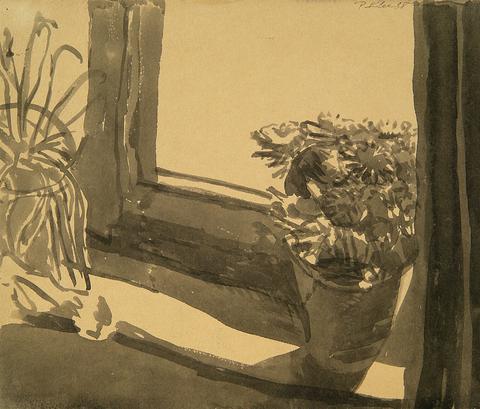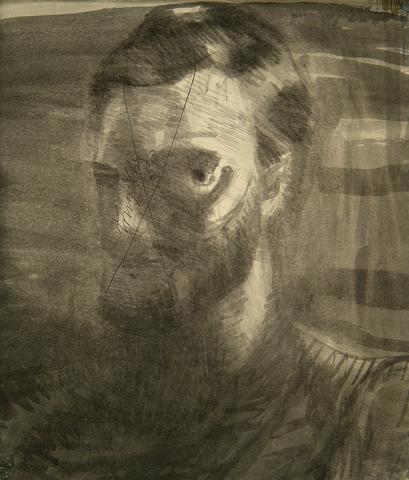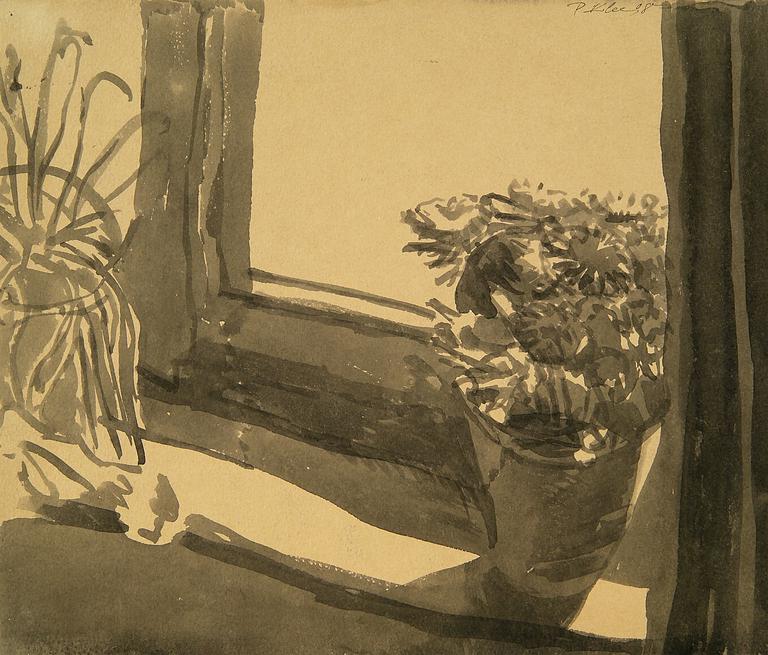
Asters à la fenêtre ; Autoportrait (au revers)
Paul Klee (1879 Münchenbuchsee - 1940 Muralto)
1908
Aquarelle en noir sur vélin teinté en jaune ; 20 x 23 cm
Provenance :
Berne, collection Charles Bornand, puis par descendance ; Berne, Kornfeld, 15 juin 2012 ; Paris, collection privée.
Exposition :
Paul Klee (Berne-Zurich-Winthertur, 1910-1911) ; Paul Klee (Berne, Kunsthalle, 1931) ; Paul Klee (Bâle, Kunsthalle, 1967).
Bibliographie :
Paul Klee Foundation, Catalogue raisonné, vol. I, Londres, 1998, n° 354.
Cette rare œuvre figurative date des débuts de Paul Klee. Il a vingt neuf ans, marié, jeune père de famille, et vit dans un trois pièces dans le quartier bohème de Schwabing, à Munich. Il a renoncé à la carrière de musicien pour une vie d’artiste qui ne le nourrit pas encore (il aura sa première exposition personnelle en 1910), et confie à son Journal ses réflexions, ses hésitations.
Il s’est d’abord exprimé par la gravure. Il a mis au point en 1903 une technique originale consistant à noircir une plaque de verre dont il dégageait un dessin en grattant à l’aiguille. La suite des Inventionen est exposée à la Sécession de Munich en 1906. Il est fasciné par Cézanne et Van Gogh qu’il a découverts à Paris en 1905 : n’ont-ils pas montré que la figuration et particulièrement le choix de la nature morte comme motif pouvaient ouvrir la voie à l’invention de la modernité ?
En se confrontant au motif par le noir et blanc, il entend, selon ses propres mots, « distinguer la tonalité (avec ou sans couleurs) du chromatisme » (Journal, 1908). Avant de se confronter à la peinture à l’huile et à la couleur, il veut explorer les effets de lumière avec « l’aquarelle en noir » (Schwarzaquarell). Il décrit le procédé dans son Journal et ce dessin en est le parfait exemple : « Moyennant une première couche, je ménageais en blanc les lumières principales. Cette couche d’un gris clair prononcé est par elle-même d’un effet parfaitement raisonnable, parce qu’elle paraît toute sombre sur du blanc (…). De la sorte, je progresse par degrés jusqu’aux notes les plus profondes, et je tiens ce dosage "chronographique" pour fondamental quant à la tonalité. » (Journal, 1908).
C’est d’un coup de soleil sur le rebord de la fenêtre de cet intérieur confiné qu’il réussit à livrer le portrait dans les tonalités de gris-brun. Au revers, longtemps caché par le montage, se trouve la contrepartie sombre à cette merveilleuse nature morte, un autoportrait esquissé selon la même technique, mais rageusement biffé par l’artiste. On y saisit à la dérobée les angoisses qui taraudent le jeune Paul Klee, et qu’il tente d’exorciser dans son Journal.
L’histoire de ce dessin et de son rôle dans la vie de Klee ne s’arrête pas là. En 1914, Klee veut entreprendre avec son ami Louis Moilliet et le peintre August Macke un voyage en Tunisie. Klee cède alors au pharmacien et collectionneur bernois Charles Bornand huit aquarelles en noir peintes entre 1908 et 1911, dont la nôtre, en échange de quoi celui-ci s’engage à assumer les frais du voyage. Le voyage en Tunisie marquera un tournant dans la vie et la carrière de Klee. Il confie à son Journal sa résolution de devenir peintre et le deviendra effectivement, par la maîtrise de la couleur...

